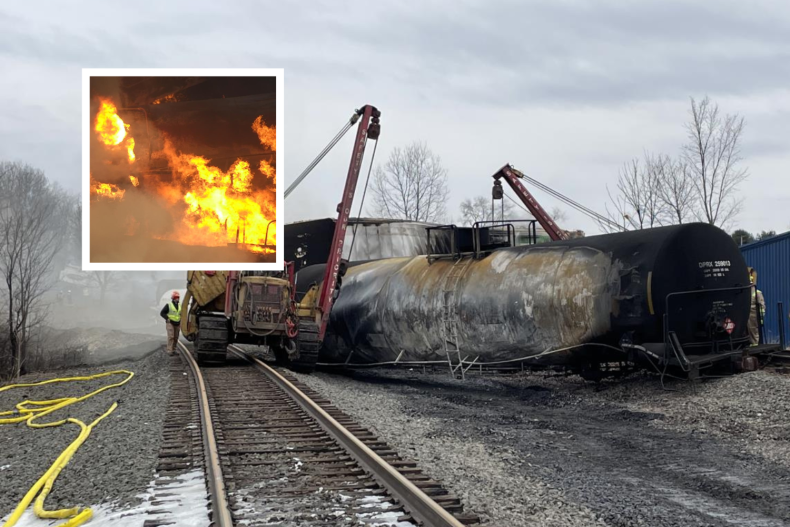Ohio Derailment: Investigation Into Persistent Toxic Chemicals In Buildings

Table of Contents
Types of Persistent Toxic Chemicals Found
The Ohio derailment released a cocktail of hazardous materials, many of which are known for their persistence in the environment and potential for long-term health impacts. Key chemicals of concern include vinyl chloride, butyl acrylate, and ethylene glycol monobutyl ether. These substances, along with other potentially harmful compounds, represent a significant challenge in assessing and mitigating the long-term consequences of the derailment.
-
Vinyl chloride: A known carcinogen, vinyl chloride is particularly concerning due to its volatility and potential for long-term persistence in building materials. Exposure can lead to liver damage, respiratory problems, and an increased risk of various cancers.
-
Butyl acrylate: This chemical is an irritant that can affect the eyes, skin, and respiratory system. While less persistent than vinyl chloride, its presence in buildings still poses a significant health risk, especially for vulnerable populations.
-
Ethylene glycol monobutyl ether (EGMBE): This chemical is known to cause irritation and, in higher concentrations, can affect the central nervous system and kidneys. Its presence in the environment adds to the complex challenge of assessing the overall toxicity of the derailment’s aftermath.
Chemical analysis methods used to detect these substances in buildings include air sampling, water sampling, and soil sampling, with testing focusing on materials like drywall, insulation, and carpeting which may have absorbed the chemicals. The persistent nature of these chemicals and their potential for bioaccumulation necessitate long-term monitoring and careful analysis.
Investigation Methods and Challenges
Assessing the extent of building contamination following the Ohio derailment presents significant logistical and scientific challenges. The investigation involves a multi-pronged approach, including:
-
Environmental testing: This encompasses air sampling to measure airborne concentrations of volatile organic compounds (VOCs), water sampling to check for contamination of drinking water supplies and groundwater, and soil sampling to determine the level of contamination in the surrounding earth.
-
Building inspections: Visual inspections are conducted to identify any visible signs of damage or contamination, guiding more targeted testing. However, many contaminants are invisible, requiring sophisticated laboratory analysis.
-
Regulatory agency involvement: The Environmental Protection Agency (EPA) and other state and local agencies play a crucial role in overseeing the investigation, setting testing standards, and coordinating remediation efforts.
However, challenges abound. Identifying and quantifying persistent chemicals within building materials is complex, requiring specialized techniques and expensive laboratory analysis. Accessing and testing all potentially affected buildings poses a logistical hurdle, further complicated by the need to balance the urgency of the situation with the need for rigorous scientific accuracy. The potential for false negatives, where contamination goes undetected due to limitations in testing methods, also adds to the complexity.
Health Risks and Long-Term Impacts
Exposure to the toxic chemicals released during the Ohio derailment poses significant short-term and long-term health risks to residents in the vicinity. Potential health effects include:
-
Respiratory problems: Irritation, coughing, wheezing, and potentially more serious respiratory illnesses.
-
Increased cancer risk: Vinyl chloride and other chemicals are known carcinogens, significantly increasing the risk of various cancers over a lifetime.
-
Neurological damage: Some chemicals can affect the nervous system, leading to headaches, dizziness, and other neurological symptoms.
-
Reproductive health issues: Certain chemicals may interfere with reproductive health, potentially impacting fertility and fetal development.
Long-term health consequences remain a major concern. Ongoing medical monitoring of affected populations is crucial to track potential health problems and provide appropriate medical care. The psychological impact on residents, living with the uncertainty and anxiety related to potential long-term health effects, is also a significant factor to consider.
Remediation and Cleanup Efforts
Remediation efforts following the Ohio derailment are focused on removing or mitigating the presence of toxic chemicals in buildings and the surrounding environment. Strategies employed include:
-
Building decontamination: This may involve specialized cleaning, removal of contaminated materials, and air filtration to reduce airborne concentrations of hazardous substances.
-
Environmental cleanup: This includes soil remediation, water treatment, and efforts to contain and remove contaminated materials from the surrounding environment.
-
Long-term monitoring: Continuous monitoring of air, water, and soil is critical to assess the effectiveness of remediation efforts and identify any potential long-term environmental impacts.
The cost of these cleanup efforts is substantial, requiring significant financial resources and coordination among various stakeholders, including government agencies, private companies, and affected residents. The challenge of effectively decontaminating porous building materials, where chemicals may have already permeated, underscores the complexity and the potential for long-term repercussions.
Conclusion
The Ohio train derailment presents a complex and ongoing environmental disaster with far-reaching consequences. The lingering threat of persistent toxic chemicals in buildings poses significant health risks to residents and necessitates a comprehensive and prolonged investigation. The challenges of detection, remediation, and long-term health monitoring underscore the need for transparency, accountability, and a sustained commitment to protecting the health and well-being of the affected community. Understanding the persistent risks of the Ohio derailment and the need for thorough investigation of toxic chemicals in buildings is crucial. Stay informed about the ongoing developments and advocate for comprehensive cleanup efforts and long-term health monitoring for the affected community. Demand transparency and accountability in addressing the impact of this environmental disaster and preventing future occurrences. Learn more about the ongoing investigation into the Ohio derailment and the persistent toxic chemicals impacting the region.

Featured Posts
-
 Tongas Victory Qualification For Ofc U 19 Womens Championship 2025
May 01, 2025
Tongas Victory Qualification For Ofc U 19 Womens Championship 2025
May 01, 2025 -
 Windstar Cruises A Foodies Voyage
May 01, 2025
Windstar Cruises A Foodies Voyage
May 01, 2025 -
 000 Pontoi I Klironomia Toy Lempron Tzeims
May 01, 2025
000 Pontoi I Klironomia Toy Lempron Tzeims
May 01, 2025 -
 Rekord Ovechkina Kinopoisk Darit Unikalnye Soski Novorozhdennym
May 01, 2025
Rekord Ovechkina Kinopoisk Darit Unikalnye Soski Novorozhdennym
May 01, 2025 -
 Targets Shifting Dei Strategy Causes Effects And Future Implications
May 01, 2025
Targets Shifting Dei Strategy Causes Effects And Future Implications
May 01, 2025
Latest Posts
-
 Il Caso Becciu Analisi Delle Preghiere E Delle Richieste Di Dimissioni
May 01, 2025
Il Caso Becciu Analisi Delle Preghiere E Delle Richieste Di Dimissioni
May 01, 2025 -
 Papa Francesco Cardinale Becciu E Le Preghiere Dei Fedeli Un Aggiornamento
May 01, 2025
Papa Francesco Cardinale Becciu E Le Preghiere Dei Fedeli Un Aggiornamento
May 01, 2025 -
 Chat E Accuse L Inchiesta Sul Complotto Becciu Secondo Domani
May 01, 2025
Chat E Accuse L Inchiesta Sul Complotto Becciu Secondo Domani
May 01, 2025 -
 Papa Card Becciu Le Nostre Preghiere E Le Speculazioni Sulle Dimissioni
May 01, 2025
Papa Card Becciu Le Nostre Preghiere E Le Speculazioni Sulle Dimissioni
May 01, 2025 -
 Mario Nanni Ricordando La Sua Eredita Nel Giornalismo Politico
May 01, 2025
Mario Nanni Ricordando La Sua Eredita Nel Giornalismo Politico
May 01, 2025
